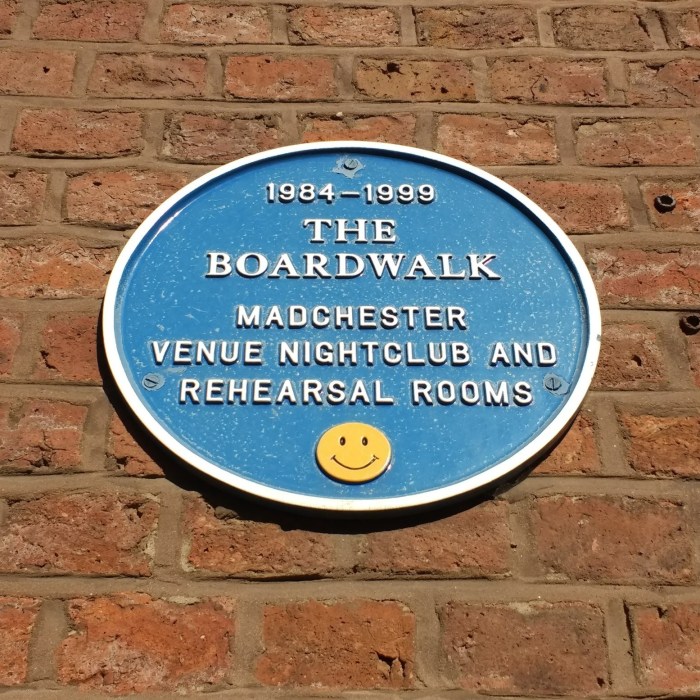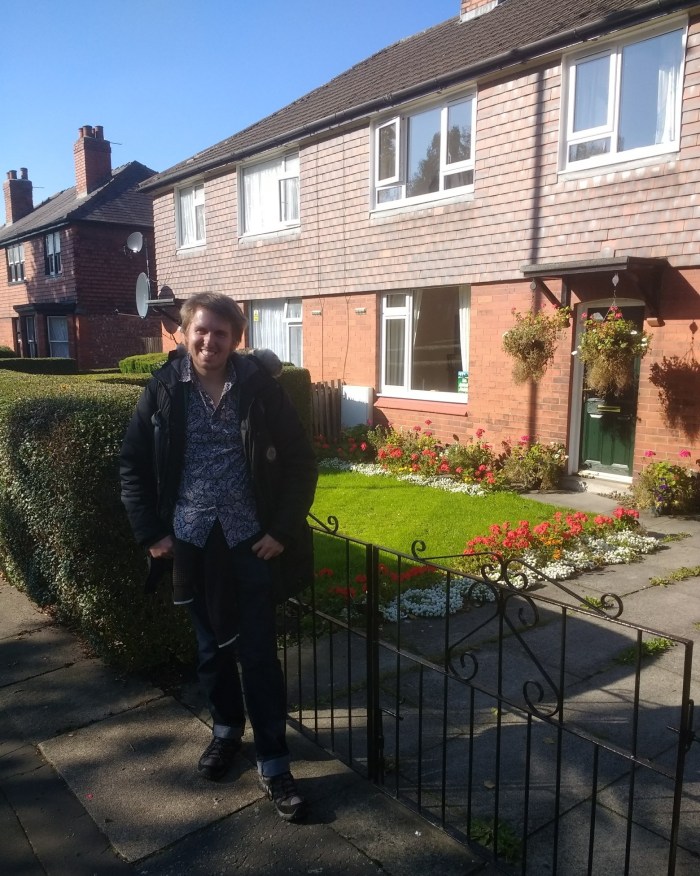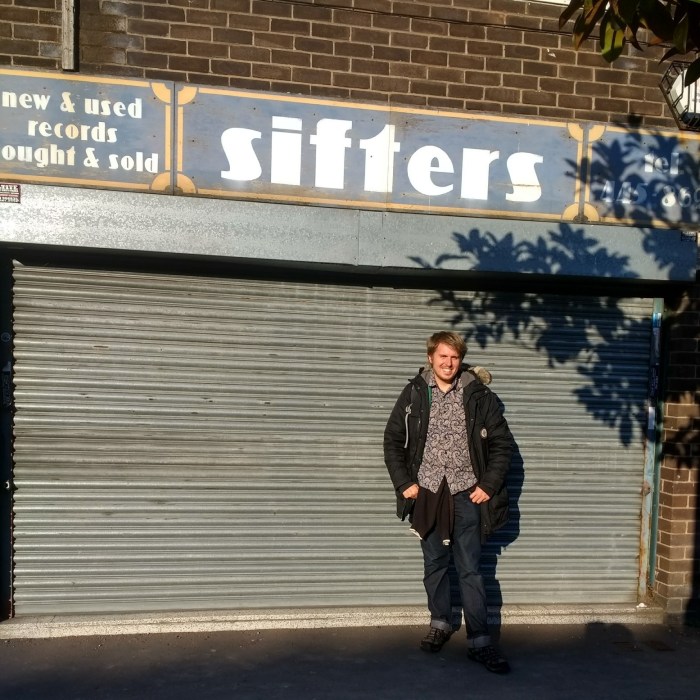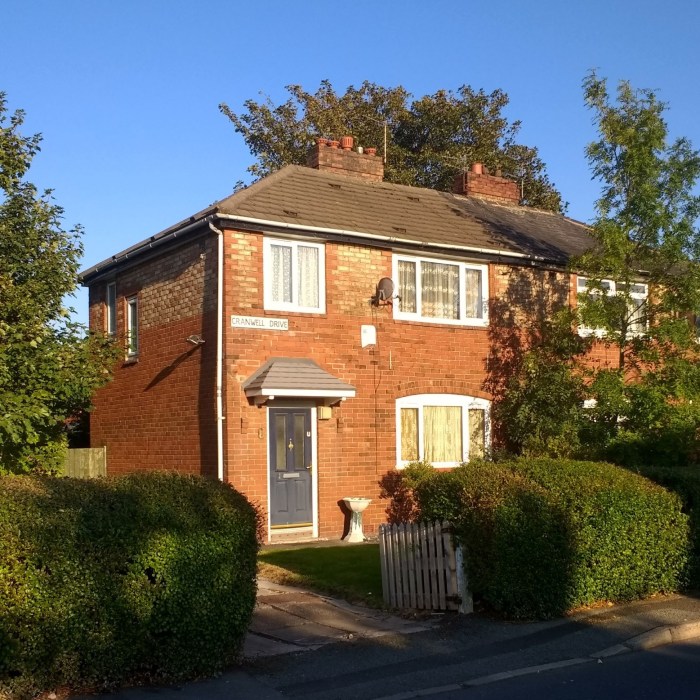
A lot of the music I regularly used to listen to in my younger years came from the city of Manchester. Joy Division, New Order, The Fall, The Buzzcocks, The Smiths, The Stone Roses, The Happy Mondays and Oasis all hail from this city. I would need a good few weeks to navigate the entire musical map of Manchester, but since I only had a day for this, I had to be selective.
From my modest Air BnB lodging, located in the district of Higher Broughton in the north of the city, I take a city bus towards Strangeways prison. You may think what on earth does a prison have to do with Manchester’s music scene? It was however referenced in the final album by The Smiths, Strangeways Here We Come. Located in an industrial and non-descript part of the city, the entrance to Strangeways is an architectural gem. There are not many people passing by on this early morning and I don’t feel the urge for some unfortunate to take my picture next to the gates. I am glad I didn’t.

The entrance to Strangeways prison
From Strangeways I walk towards the Arndale Shopping Centre in the centre of the city. I was hoping that today would be an overcast day to set the scene for the places I’d be visiting, but there’s sadly not a cloud in sight. I am truly disappointed. After purchasing a sandwich at Sainsbury’s Local, I board the city tram for Deansgate located on the southern edge of the city centre.
Close to Deansgate station I only have to walk a short distance until I am face to face with the site of the legendary Hacienda nightclub. During those heady ‘Madchester’ days during the late 1980s and early 1990s, the Hacienda was well and truly bopping with a big enough supply of ecstasy doing the rounds to fill a good few Olympic swimming pools. Today the site of the club is now home to a block of luxury apartments.

By the site of the Hacienda nightclub
A brief history of the Hacienda and its origins. The club was originally established by the founder of Factory Records, Tony Wilson, in the early 1980s. Factory Records played a central role in Manchester’s music scene since the late 1970s signing Joy Division (and subsequently New Order), the Happy Mondays and many other local bands. As instrumental as the label was to the local music scene, it was also victim to a streak of tremendous bad luck in failing to sign some of the city’s most successful talent. It came very close to signing The Smiths (yet Wilson doubted Morrissey’s potential and ability to be a pop star and encouraged him to be a novelist instead), missed the boat with The Stone Roses, and, allegedly, turned down Oasis. Much of the funds for the establishment and running of the Hacienda came directly from New Order’s royalties. The Happy Mondays, despite their commercial success, contributed towards the financial downfall and bankruptcy of Factory Records in the early 1990s. Yet it was very much the irresponsibility of Tony Wilson to give the band upfront an advance of almost £1m in cash to record their final album in Barbados in 1992. Most of the money went up, literally, in crack smoke and very little towards the actual recording of the album. The Hacienda plodded on for a few more years before shutting its doors permanently. Yet in it’s heyday during the late 1980s it was the place to be and the coolest club not just in the city of Manchester but across the whole country if not the world.
Also close to Deansgate station is the original site of the Broadwalk, which was a small live music venue in the city. For me it will be forever associated with the place where Oasis played their first live gig in 1991. Back then Noel Gallagher was a roadie for the Oldham band The Inspiral Carpets. It was only when he joined the band a year later in 1992, establishing himself as the main songwriter and driving force, that Oasis began to develop. In 1993, Oasis played a brief set at the King Tuts Wah Wah club in Glasgow, where Creation records founder Alan McGee spotted the band and signed them to his record label. The rest is over documented music history.

Site of the Broadwalk music venue where Oasis played their first ever gig in 1991
From Deansgate I catch a bus out of the city centre to Salford. I must add that Google maps has been of great assistance in helping me navigate this city, finding the right buses and trams and, more importantly, saving me a good deal of time. After a few stops on the bus, I disembark off a busy dual carriageway close to a large Sainsbury’s supermarket. I desperately need to pee. I resist the temptation to do it near a bush close to a housing estate and duly cross the dual carriageway making a dash for the toilets inside Sainsbury’s. Returning to the bus stop, I walk a few blocks through a series of quiet residential streets until I encounter the iconic redbrick building of The Salford Lads Club. It was of course here where The Smiths posed for that infamous photo featured inside their seminal The Queen Is Dead album. I find a passer-by to take a photograph of me by this legendary site.

By the iconic Salford Lads Club; a place forever associated with The Smiths

The Smiths at that same location
A couple of blocks away is a bus stop with a direct bus to the district of Stretford. The Old Trafford, the location of Manchester United football club, is located over there, yet it isn’t football I’ve come for. Stretford is where a young Stephen Patrick Morrissey once lived before finding fame as the lead singer and lyricist of The Smiths. From the bus stop where I disembark, it is a 15 minute walk to reach his house located on Kings Road. When I approach the junction with Kings Road, there is a cheap takeaway joint serving kebabs, pizza and fried chicken. The childhood home of the one of the most celebrated vegans on the planet is about a two-minute walk away. I am mighty hungry, but I resist the urge to purchase a ‘donar wrap’ en-route to Chez Moz.
Kings Road is one wide empty street full of predominantly semi-detached suburban houses. I soon arrive at number 384. In one of the small top floor rooms of this house, an adolescent Morrissey would be furiously typing verse on his typewriter, reading Oscar Wilde and listening to The New York Dolls, Sparks, Sandie Shaw and other acts beloved by him. Oh, and the curtains would be forever closed. Morrissey often dreamt of stardom regardless of how remote the chances seemed to be for a cripplingly shy young man from greater Manchester. In fact, although Morrissey mixed with the local music scene of the city during the late 1970s and early 1980s, the consensus around that time was that he was the least likely person to make it as a pop star from that scene. And any such notion was immediately ridiculed. He was best known as the village idiot. Steve The Nutter. Bad judgement. The rise of Morrissey into one of the most iconic and influential pop stars of all time is one of the greatest black swan events ever to occur in the history of popular music. Nobody saw it coming.

At 348 Kings Road in the Manchester district of Stretford; The home of an adolescent Morrissey

A photograph of an adolescent pre-quiffed Morrissey taken during the late 1970s

In the 1980s as lead singer of The Smiths
It was at this very address that, one day in 1982, a young guitarist by the name of John Maher (later better known as Johnny Marr), rang the doorbell to enquire as to whether Stephen would be interested in being the singer for a new band he was trying to put together. Morrissey could’ve easily just told the boy to go away, but thankfully he didn’t as this encounter would eventually change his life, propelling him from the bedroom to global stardom.
Leaving 384 Kings Road, I walk for some time towards the nearest tram metro stop, from where I board a tram all the way to the southern Manchester district of Didsbury Village. Didsbury Village is a well-heeled part of the city reminiscent perhaps of Hampstead or Muswell Hill in North London. I take a break here and order some lunch. There are some great charity shops in this neck of the woods too. Didsbury Village is the springboard for the less well-heeled district of Burnage, where the home of a young Liam and Noel Gallagher is located.
Walking away from Didsbury Village and past Burnage train station, I soon locate Sifters record shop. This is the place where Liam, Noel and their older brother Paul used to buy (or maybe, dare I say, pilfer?) their records. It is also namechecked in the early 1994 Oasis single Shakermaker in the line, ‘Mr Sifter sold me songs when I was just fifteen’. Unfortunately, the shutter is down. I read that today it was supposed to close at 5pm yet its currently only after 3pm. Perhaps Mr Sifter wanted a day off? Nevertheless, I get a young tattooed lad on his bike to take a picture of me by the shop.

By Sifters Records in Burnage; a popular haunt of the Gallagher brothers
Now I commence the final part of the tour towards the home of the Gallagher boys. Burnage is a rather sedate part of the city. Nothing much goes down here. Yet its in no way the craphouse that perhaps Noel makes it out to be. The only other landmark I remember is some large Chinese restaurant whose name I can’t recall. Past the busy Kingsway dual carriageway I carry on towards Burnage Lane before arriving at Cranwell Drive where their old home is located. It’s a modest nondescript semi and that is all.

The home of a young Liam and Noel Gallagher

Early photo of the Gallagher brothers (Noel, Paul and Liam) with their mother Peggy

Photo of Liam and Noel taken sometime in the 1990s
Many years ago, I read their brother Paul’s book on their upbringing and it was a pretty shocking read. Their father Tommy was a violent man who used to beat Paul and Noel regularly as well as their mother Peggy. Thankfully, sometime around the early 1980s, the local council were able to move their mother and the boys to another house and this is the house. I believe their mother still lives there, but I could be wrong. As with Morrissey’s childhood home, I refrain from knocking the door out of respect for the privacy of the current residents as tempting as it may have been.
I have no desire to linger longer in Burnage so I catch a bus on the Kingsway road back to central Manchester for a well-deserved pint.
By Nicholas Peart
©All Rights Reserved